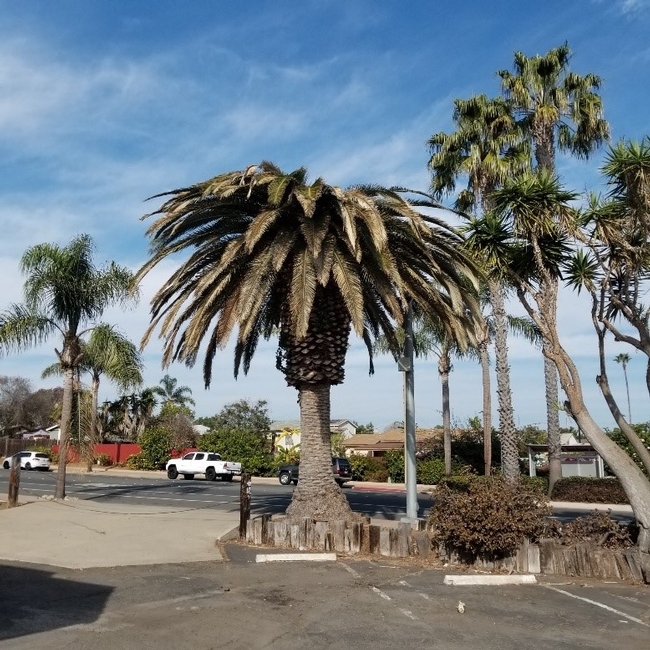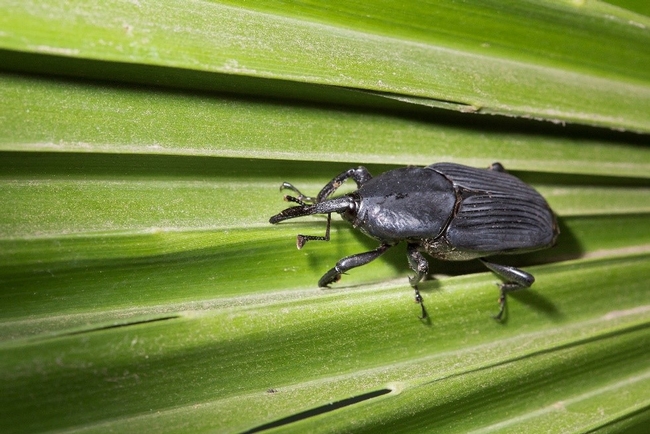Date growers in the California deserts have many insects to worry about such as carob moth, hibiscus mealybug, and giant palm borer. Now the industry is under threat from another potential pest, the highly damaging and invasive South American palm weevil (SAPW) (Rhynchophorus palmarum). It was first identified by county and state agriculture officials in 2011 in San Ysidro in San Diego. They made the discovery while looking for a closely related palm weevil, R. vulneratus (originally mis-identified as the notorious red palm weevil, R. ferrugineus), which was found in Laguna Beach and declared eradicated in Jan. 2015.SAPW has been reported on at least 35 plant species in 12 families and is especially economically important on plantation crops such as oil and ornamental palms of which date palm, Phoenix dactylifera, is a recorded host (CABI 2016; Dean 1979; Esser and Meredith 1987). SAPW has killed hundreds of Canary Island date palms (P. canariensis) in Tijuana and parts of San Diego County. These large urban infestations pose a significant risk to the multi-million dollar date palm industries (edible fruit and ornamentals) in the Coachella Valley. Losses of ornamental Canary Island date palms in San Diego County, are probably significant and likely now reaching millions of dollars in killed palms, reduced aesthetics, and increase removal costs.
SAPW has a long rostrum (this is the beetle's snout) and is large often up to 1 ½ inches to 2 inches in length (CDFA 2018). SAPW is now California's biggest weevil species! Inside the palm crown, weevil larvae feed on the meristematic tissue and it is this feeding that kills the palm crown which results in palm death. Larvae pupate inside 3-inch cocoons made of palm fibers. The pupal stage typically lasts two to three weeks. Adult weevils emerge from these protective cocoons, mate, and they are capable of flying significant distances, perhaps as far as 15 miles in a single day, to find new palm hosts. Female weevils use their snout to chew holes in the apical regions of the palm and they lay eggs in these holes. Larvae that hatch from eggs burrow into the palm crown and feed turning the meristem tissue in a fermenting “mash”. Feeding wounds that result in fermenting damage in association with aggregation pheromone released by male weevils create a highly attractive airborne cocktail of odors that weevils fly too. Adult weevils can live for at least 40 days, often longer (CDFA, 2018).
A single infected palm can result in the production of hundreds of weevils and detection of weevil infested palms at the early stages of attack can be difficult to identify because larvae live inside their host trees. The first obvious symptom of attack is a crown that is starting to collapse. Unless palms are treated within systemic insecticides at the early stages of attack, infested palms will ultimately die in as little as 2-3 months once visual symptoms become apparent.
In addition to direct physical damage SAPW inflict via feeding, it is a primary vector of the nematode that causes red ring disease (RRD), a fatal wilt disease of palms. Fortunately, RRD has not yet been detected in SAPWs or palms attacked in San Diego (Hoddle et. al. 2016). Removal of infected trees is necessary not only to remove breeding weevil populations from the environment, but also to minimize risk of harm to people, pets, and property from crown and frond drop.
More information on the SAPW invasion and to report suspect palms please visit this website: http://cisr.ucr.edu/palmarum.html


